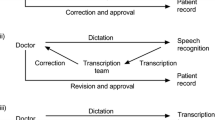Abstract
Objective
The purpose of this study is to analyze an automated voice to text translation device by reporting the translation accuracy for recorded pediatric neurosurgery clinic conversations, classifying errors in translation according to their impact on overall understanding, and comparing the incidence of these errors in English to Spanish vs. Spanish to English conversations.
Methods
English and Spanish speaking patients at a single academic health system’s outpatient pediatric neurosurgery clinic had their conversations recorded. These recordings were played back to a Google Pixel handheld smartphone with Live Translate voice to text translation software. A certified medical interpreter evaluated recordings for incidence of minor errors, errors impacting understanding, and catastrophic errors affecting patient-provider relationship or care. Two proportion t-testing was used to compare these outcomes.
Results
50 patient visits were recorded: 40 English recordings translated to Spanish and 10 Spanish recordings translated to English. The mean transcript length was 4244 ± 992 words. The overall accuracy was 98.2% ± 0.5%. On average, 46 words were missed in translation (1.09% error rate), 31 understanding-altering translation errors (0.73% error rate), and 0 catastrophic errors were made. There was no significant difference in English to Spanish or vice versa.
Conclusion
Voice to text translation devices using automatic speech recognition accurately translate recorded clinic conversations between Spanish and English with high accuracy and low incidence of errors impacting medical care or understanding. Further study should investigate additional languages, assess patient preferences and potential concerns with respect to device use, and compare these devices directly to medical interpreters in live clinic settings.
Similar content being viewed by others
Data availability
Please contact corresponding author Ben Succop at benjamin_succop@med.unc.edu to request data and materials used for this manuscript.
References
Hartley BR, Elowitz E (2020) Future directions in communication in Neurosurgery. World Neurosurg 133:474–482. https://doi.org/10.1016/j.wneu.2019.08.132
Huntington B, Kuhn N (2003) Communication Gaffes: A Root Cause of Malpractice Claims. Baylor University Medical Center Proceedings. ;16(2):157–161. https://doi.org/10.1080/08998280.2003.11927898
Richards J, Mcdonald BP (1985) Doctor-Patient Communication in Surgery’. Vol 78
Wynia MK, Osborn CY (2010) Health Literacy and Communication Quality in Health Care Organizations. J Health Commun 15(sup2):102–115. https://doi.org/10.1080/10810730.2010.499981
Hartley BR, Hong C, Elowitz E (2020) Communication in Neurosurgery—the Tower of Babel. World Neurosurg 133:457–465. https://doi.org/10.1016/j.wneu.2019.08.134
Mǎrginean CO, Meliţ LE, Chinceşan M et al (2017) Communication skills in pediatrics - the relationship between pediatrician and child. Med (United States) 96(43). https://doi.org/10.1097/MD.0000000000008399
Kuo DZ, O’Connor KG, Flores G, Minkovitz CS (2007) Pediatricians’ Use of Language services for families with Limited English proficiency. Pediatrics 119(4):e920–e927. https://doi.org/10.1542/peds.2006-1508
Kelson M, Nguyen A, Chaudhry A, Roth P (2022) Improving patient satisfaction in the Hispanic American Community. Cureus Published Online August 7. https://doi.org/10.7759/cureus.27739
Jaeger FN, Pellaud N, Laville B, Klauser P (2019) Barriers to and solutions for addressing insufficient professional interpreter use in primary healthcare. BMC Health Serv Res 19(1). https://doi.org/10.1186/s12913-019-4628-6
Randhawa G, Ferreyra M, Ahmed R, Ezzat O, Pottie K (2013) Using machine translation in clinical practice. Can Fam Physician 59(4):382–383
Panayiotou A, Gardner A, Williams S et al (2019) Language Translation Apps in Health Care settings: Expert Opinion. JMIR Mhealth Uhealth 7(4):e11316. https://doi.org/10.2196/11316
Dew KN, Turner AM, Choi YK, Bosold A, Kirchhoff K (2018) Development of machine translation technology for assisting health communication: a systematic review. J Biomed Inf 85:56–67. https://doi.org/10.1016/j.jbi.2018.07.018
Wu C, Xia F, Deleger L, Solti I (2011) Statistical machine translation for biomedical text: are we there yet? AMIA Annu Symp Proc 2011:1290–1299
Bernadette RC, Al-Mohaish S, Sun Y, Christopher J, Edwards Accuracy of Google Translate in translating the directions and counseling points for top-selling drugs from English to Arabic, Chinese, and Spanish, American Journal of Health-System Pharmacy, 78, Issue 22, 15 November 2021, Pages 2053–2058, https://doi.org/10.1093/ajhp/zxab224
Kwame A, Petrucka PM (2021) A literature-based study of patient-centered care and communication in nurse-patient interactions: barriers, facilitators, and the way forward. BMC Nurs 20(1):158. https://doi.org/10.1186/s12912-021-00684-2
Brach C, Fraser I, Paez K (2005) Crossing the Language Chasm. Health Aff 24(2):424–434. https://doi.org/10.1377/hlthaff.24.2.424
Moleman M, Regeer BJ, Schuitmaker-Warnaar TJ (2021) Shared decision‐making and the nuances of clinical work: concepts, barriers and opportunities for a dynamic model. J Eval Clin Pract 27(4):926–934. https://doi.org/10.1111/jep.13507
Chang DS, Chen WL, Wang R (2022) Impact of the bidirectional relationship between communication and cognitive efficacy on orthopedic patient adherence behavior. BMC Health Serv Res 22(1):199. https://doi.org/10.1186/s12913-022-07575-5
Elwyn G, Frosch D, Thomson R et al (2012) Shared decision making: a model for clinical practice. J Gen Intern Med 27(10):1361–1367. https://doi.org/10.1007/s11606-012-2077-6
Karliner LS, Jacobs EA, Chen AH, Mutha S (2007) Do Professional interpreters improve clinical care for patients with Limited English proficiency? A systematic review of the literature. Health Serv Res 42(2):727–754. https://doi.org/10.1111/j.1475-6773.2006.00629.x
Escobedo LE, Cervantes L, Havranek E (2023) Barriers in Healthcare for Latinx Patients with Limited English Proficiency—a Narrative Review. J Gen Intern Med. Published online January 31, https://doi.org/10.1007/s11606-022-07995-3
Funding
This project was funded wholly by the nonprofit Carolina for the Kids (CFTK) grant.
Author information
Authors and Affiliations
Contributions
B.S., M.C., and H.B. wrote the main manuscript text. G.H. and B.A. prepared the tables. S.E. and C.Q. provided faculty support. All authors reviewed the manuscript and provided edits prior to submission.
Corresponding author
Ethics declarations
Conflict of interest
The authors have no conflicts of interest to disclose.
Ethical approval
This project was overseen by the UNC Office of Human Research Ethics (OHRE) institutional review board, IRB 19-2105.
Additional information
Publisher’s Note
Springer Nature remains neutral with regard to jurisdictional claims in published maps and institutional affiliations.
Rights and permissions
Springer Nature or its licensor (e.g. a society or other partner) holds exclusive rights to this article under a publishing agreement with the author(s) or other rightsholder(s); author self-archiving of the accepted manuscript version of this article is solely governed by the terms of such publishing agreement and applicable law.
About this article
Cite this article
Succop, B., Currin, M., Hesse, G. et al. Automated translation accurately translates recorded pediatric neurosurgery clinic conversations between Spanish and English. Neurosurg Rev 47, 210 (2024). https://doi.org/10.1007/s10143-024-02441-w
Received:
Revised:
Accepted:
Published:
DOI: https://doi.org/10.1007/s10143-024-02441-w




